Our History
The History of St Andrews Golf Club, Trinidad & Tobago
St Andrews Golf Club Trinidad was established at the Queen’s Park Savannah in Port of Spain on October 31st, 1891. It is the third golf club in the world named St Andrews after the St Andrews Golf Club in St Andrews, Scotland (1754) and the St Andrews Golf Club of Yonkers New York which was established in 1888. It is one of the oldest Golf Clubs in the Americas and the second oldest in the Caribbean after the Manchester Golf Club in Jamaica which was established in 1865. The early historical details below were pieced together from old St. Andrews Minute Books (1923-1957) by esteemed member John Sellier.
The Queen’s Park Savannah 1891 - 1919
One of the founding members of the Club, Mr. Donald McBride informed Mr. John Sellier that he was one of a group of twelve expatriates who played golf on leased land for three years at Orange Fields, the site which the Holy Name Convent now occupies. At the time the greens on the course were merely closely mown areas with a pole in the middle. The rule was, once on the green you claimed two putts and if the ball got within a club-length of the pole you were entitled to claim one putt.
To continue playing golf in such an unconventional fashion simply would not do, hence the group decided in 1891 to register as St. Andrews Golf Club and create a proper nine-hole golf course at the Queen's Park Savannah in Port of Spain.
The members used the Queen’s Park Hotel as a Club House until 1898 after which the Club made arrangements to use the Trinidad Turf Club Members’ Stand. This was much more convenient as the first tee of the Nine-Hole Course was on the inside of the racetrack, close to the winning pole.

The Queen’s Park Hotel
It could be of interest to present day members, many of whom drive around the Savannah, to trace the direction of the course. The first hole was played north toward the Peschier Family cemetery. The second was a dogleg left around the cemetery towards Casual’s Corner where the green was situated, however the shortest route to this green was a well struck second shot over the graveyard. Unfortunately, too many errant shots were falling short and causing damage to the headstones, thus the cemetery was eventually deemed to be out of bounds. The third hole was routed from east to west with the green located opposite Queens Royal College. The fourth went north up the line of trees along Queen's Park West, but a vicious hook or pulled shot was liable to meet any vehicle such as a tram or passer-by head on, and if it missed them could well find its way into White Hall or the Archbishop’s Residence.
The 5th hole named IN, and 6th referred to as OUT was played through the Hollows toward the sixth green which was just about opposite the Governor General's Residence (now The President's House). The 7th 8th and 9th came south with the final green by the clubhouse. The playing of golf in those days must be pictured amidst grazing cattle which caused the club to have to fence the greens with barbed wire. This was the backdrop against which the first “Trinidad Amateur Championship” was played in 1907.
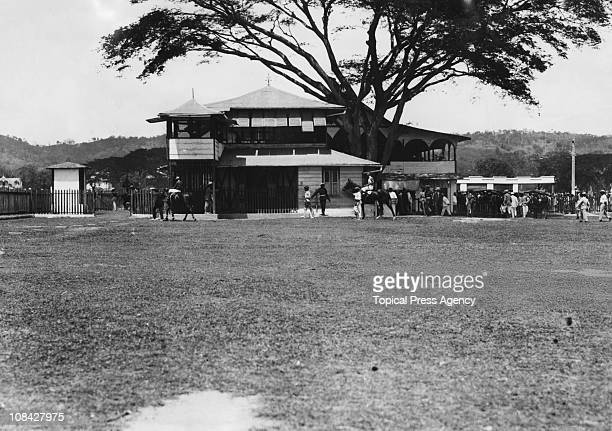
Trinidad Turf Club Paddock circa 1925
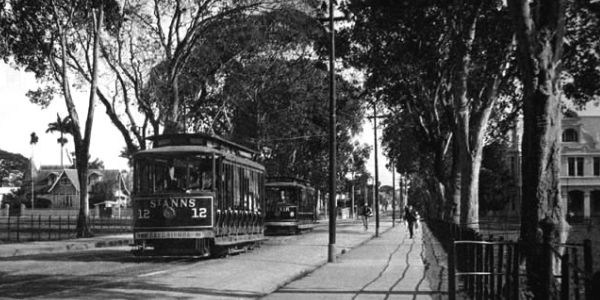
Tram cars around Queen’s Park Savannah
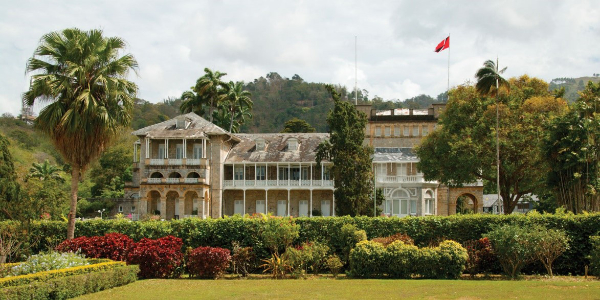
President’s House (then The Governor General’s Residence) opposite the 6th green
St James 1920 - 1934
The St. Andrews’ members used the Queens Park Savannah for 28 years up to 1919 before they moved westward to what they thought would be a less public and safer environment at St. James on a short renewable lease from the Government. There the members built a small two-storey club house located almost exactly where the St. Mary’s College Pavilion presently stands. The members parked their cars near the river and walked across a narrow rickety wooden bridge to get to the club house.
A nine-hole course was laid out on this flat piece of land which extended into Federation Park. Once again, the course was shared with grazing cattle and the greens had to be fenced with barbed wire. The golfers also shared two fairways with the Mounted Branch of the Constabulary who had priority over golfers whenever they wanted to practice their manoeuvres or train horses and riders. The Club Minutes of the time recorded several instances of frustration and inconvenience when golf was held up or cancelled due to this. In addition, there was some uncertainty around the renewal of the lease from the government for continued use of the lands for a golf course. Like so many Clubs that flourished in those days but failed to acquire their own private property, all went into extinction sooner or later. A good example of this was the all-powerful Trinidad Turf Club whose members did not secure their own freehold property. Their ultimate demise is now written in the sands of time.
Having been warned by the Acting Governor General on several occasions that the lands may soon be required for public purpose, the Club’s leadership began the search for an alternative location for the golf course. This time they would seek to obtain ownership of the property instead of leasing. The Committee set their sights on the Champs Elysees Estate that was owned by Colonel De Boissiere. A sub-committee comprising Messrs. George de Boissiere, Frank Haynes, Robert Sellier, B. H. Rose and the Secretary, Henri De Boissiere was formed to explore the potential acquisition of the estate lands.
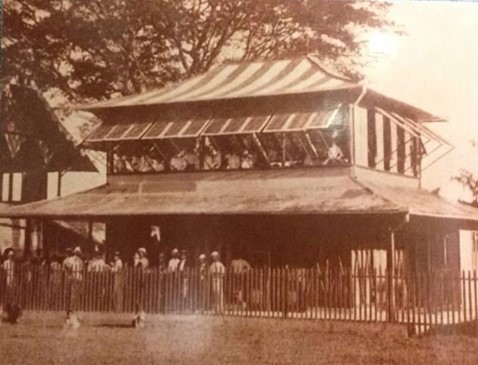
St Andrews Club House at St James (Photo at the British Golf Museum, St Andrews, Scotland)
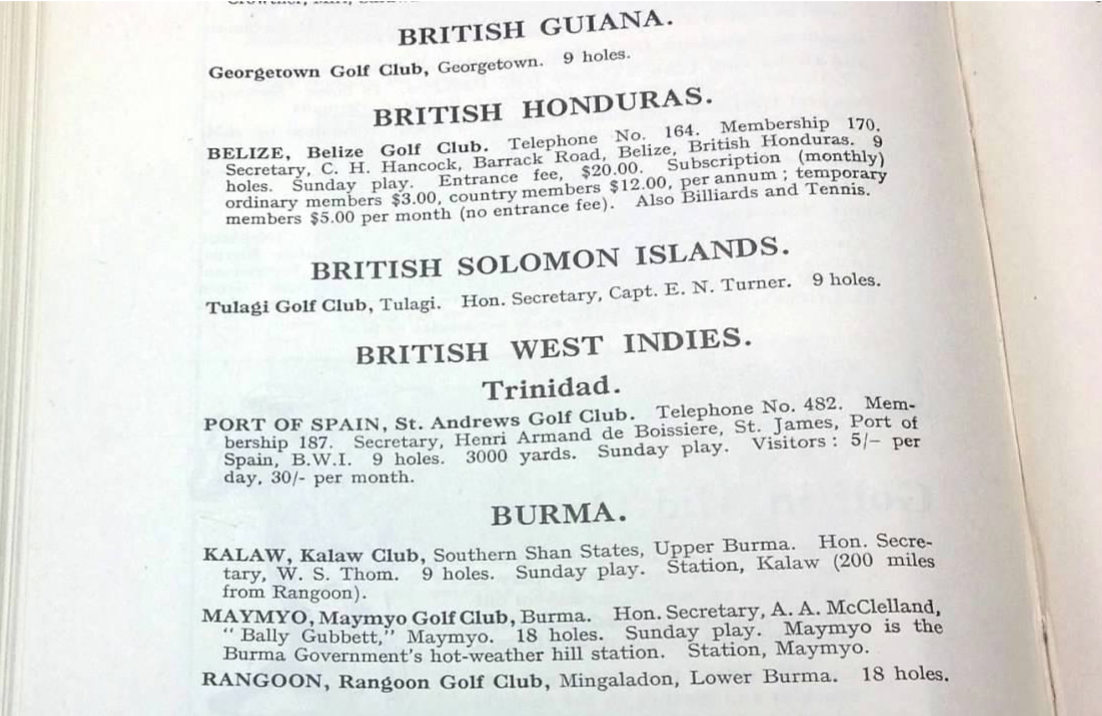
Golf Clubs of the Empire 1931 Edition (British Golf Museum)
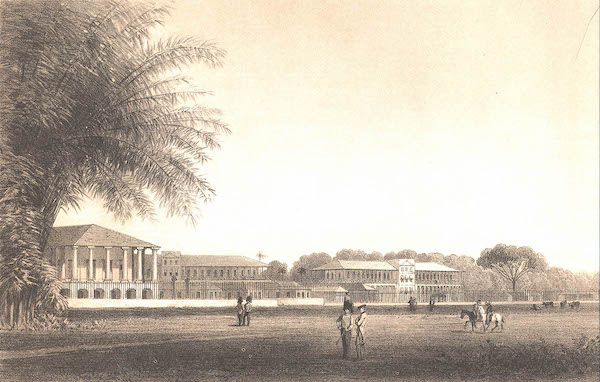
St James Barracks 1850's
Champs Elysees Estate, Maraval 1935-1974
On 22nd September 1930, it was decided to adopt the report prepared by Messrs. George De Nobriga and Frank Haynes who put their proposal before the membership at a Special General Meeting of the Club. This meeting was held on the 6th October at the Queen’s Park Hotel and was attended by 50 members. Mr. McBride then moved and was seconded by Mr. D. Fraser that the Committee, acting as the Trustees of the newly formed company Maraval Lands Limited, be authorised to purchase 96 acres of the Champs Elysees Estate in Maraval for the princely sum of $16,000. There were apparently no dissenters.
The Committee’s decision to seek an alternative site and thereby acquire their own freehold land was seminal, and lovers of the game who have joined the Club since that time are heavily indebted to them for their courage and foresight. Much credit must be given to Messrs. De Nobriga and Haynes, who did all the hard work of getting members to put up their precious hard-earned cash in the middle of an international recession.
Mr. De Nobriga, who was so instrumental in promoting the land purchase, was determined that a reputable golf course architect should be involved in the course design. Through his personal contacts in London, he was able to get one of the most renowned golf course designers in the world, H. S. “Harry” Colt (b. 1869) to do the job. The project in Trinidad so intrigued Mr. Colt that he agreed to do it for nothing. Colt’s impressive resume includes many famous courses on both sides of the Atlantic; Wentworth, Sunningdale, Royal Portrush, Muirfield, St. Georges Hill in the United Kingdom, and Pine Valley in the United States.
Aerial photographs and topographical surveys were taken of the site at Champs Elysees for Mr. Colt. Using that information, he was able to create a large hand-crafted plasticine model that was built to scale and shipped back to Trinidad to be used as the reference for the construction of the new course. Unfortunately, H.S Colt never made his way to Trinidad to view the finished product in person, but from all accounts the compact course design was a resounding success and was well received by the members.
It took four long years to arrange the finance and build the first nine holes which were all on the south side of the Golf Club Road. Some of the peripheral areas that were unsuitable for play like St Andrews Terrace was sold to raise additional funds. The second nine and clubhouse took a further 2 years and were finally completed in 1938. Therefore, the Club was 39 years old when its members acquired their own freehold property and 43 years before its members no longer had to share their golf course with tram cars, grazing cattle, mounted constabulary, football players, cricketers and, not to forget, horse racing.
During the post war period of the club’s history, golf had risen in popularity and several accomplished players emerged from St Andrews G.C in the likes of Peter Hale, Brian and Robert Grell, John Sellier and several others. Many of these gentlemen were coached by Trinidad’s first black Club Professional Mr. Fitzroy Rudder (b. 1908) who started out as a caddie but developed a talent for expert golf instruction. He was an integral part of the fabric of St. Andrews and played a major role in overseeing the construction activities of the courses at Champs Elysees and Moka. His nickname was “The Boss” but he was also dubbed “The Father of Golf” since he shaped the futures of many aspiring golfers and teaching professionals. In 1981 he was awarded the Silver Medal of Merit for outstanding public service.
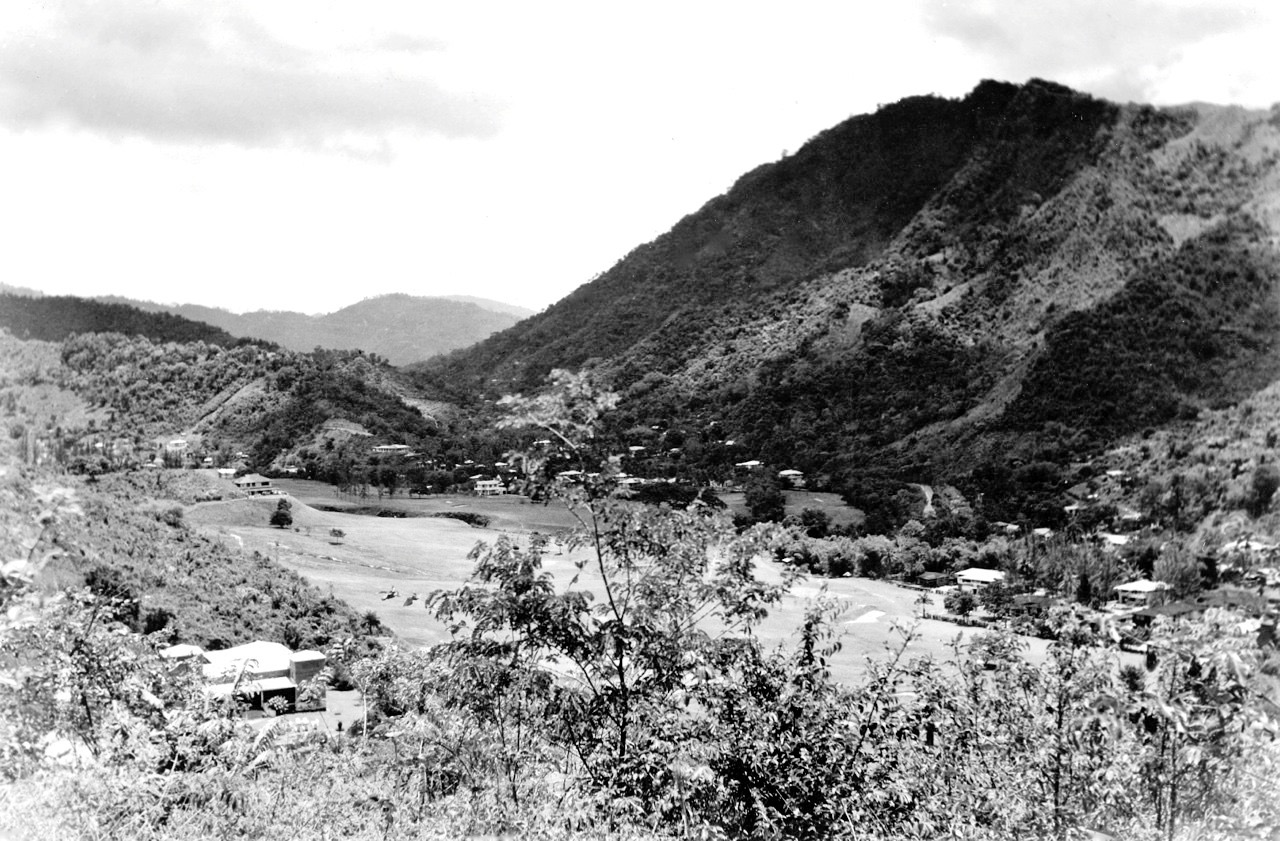
St Andrews Golf Course, Champs Elysees 1945

NORTH TEAM 1950’s
BACK: M. Blackman, F. Kirkley, R. Grell, B. Bennett, N. Slinger, R. Williams, P. Hale, R. Morton, A Sellier
FRONT: FR. I. Knox, M. Hope-Ross, B. Grell
The advent of the Hoerman Cup 1950’s
It is important to note that the Caribbean Amateur Golf Championships can be traced back to this period in St Andrews’ history, when in 1955 A.C.M. (Alan) Low, a keen golfer and member of the Constant Spring Golf Club, Jamaica, made one of his periodic business visits to Port-of-Spain, Trinidad. While visiting St. Andrews Golf Club he made the bold assertion that Jamaica would have no difficulty in beating Trinidad at golf. The challenge was taken by Horace Ames, president of the Trinidad and Tobago Golf Union.
The first match between Trinidad and Jamaica took place at Constant Spring Golf Club in May of 1956 with Jamaica winning by 10 matches to 2. It is proper to record that, officially, the visitors were not representing Trinidad and Tobago, but the St. Andrews Golf Club. It was not played for the Hoerman Cup or for any trophy at all but created so much interest that the deficiency was immediately met.
Dr. Erik Hoerman, long resident in Jamaica, and an ardent golfer conceived the idea of presenting a trophy for annual competition among Caribbean Countries. The first match took place in Jamaica in 1957 when Trinidad and Tobago captained by John Sellier beat Jamaica captained by R.G. Sturdy by 7 ½ matches to 4 1/2.
In 1958 the Trinidadians visited Jamaica at the new Caymanas Golf and Country club and were beaten by 9 ½ matches to 2 ½ . In 1959 Jamaica took a strong team to Trinidad but were beaten 10 matches to 2. Jamaica won in 1960 at Caymanas 9 matches to 3 and followed in 1961 with a victory in Trinidad at St. Andrews Golf Club 7 matches to 5. Jamaica won again at home in 1962 and lost in Trinidad in 1963 by 8 ½ matches to 3 ½ .
The competition for the Hoerman Cup expanded in 1964 when Puerto Rico joined Jamaica and Trinidad and Tobago. Medal play was introduced with the best four of six scores to count on each side. The Bahamas joined in 1965, The Dominican Republic in 1968 and Barbados in 1970.
In 1969 Dr. Jan Steele-Perkins and Ken Francis of the Bahamas donated a trophy for a four-ball competition among golfers 50 years of age and older. The inaugural senior competition was played in Trinidad and Tobago at the Point-A-Pierre Golf Club and the Bahamas team of Jan Steele-Perkins and D. Wightman were the first winners.
Courtesy Cayman Islands Golf Association
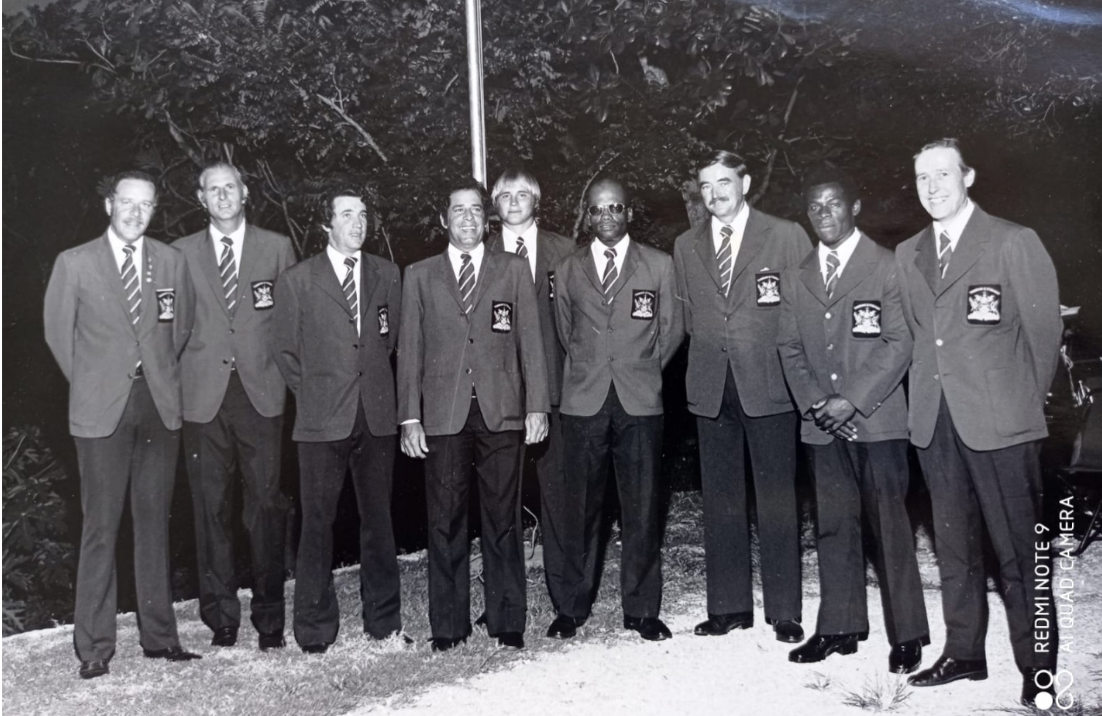
Victorious Hoerman Cup Team at Sandy Lane Barbados 1976
R. Grell, P. Hale, I. de Bruin, B. Grell, C. Harries, C. Hinds, A. Hutson, C. Yearwood, F. Hamer
Moka Maraval 1975 - Present
During the 1960s golf was booming. The likes of Arnold Palmer, Jack Nicklaus and Gary Player were commercialising golf on television and new golf courses were being built throughout the Caribbean and North America. After 40 years of golfing adventures at Champs Elysees the Club’s visionaries decided that it was time to move into the big leagues with a world class championship golf course that would have all the bells and whistles of the modern courses of the day. The picturesque Moka Valley Estate was earmarked to become the new site for the relocation. In 1972 the Harry Colt course at Champs Elysees Estate was sold to developers for $1,800,000 and is now home to the residents of Fairways.
Commander John Harris was one of the pre-eminent golf course architects on the international scene at the time and had just completed the stunning Mount Irvine Golf Course in Tobago in 1968. His firm of Harris, Thompson & Wolveridge was contracted to design the new St Andrews golf course at Moka, and their fellow associates Ron Fream & Terry Storm were assigned to execute the field work. The back 9 holes were completed first, then in the last 2 years of construction, esteemed member Peter Hale in conjunction with Greens Chairman Richard Morton worked hand in hand with Californian course superintendent Earnie Gee to complete the front nine holes.
At the time $1.8M was a considerable sum, estimated to be more than enough to purchase the Moka lands and complete the new course and clubhouse. Unfortunately, the best laid plans of mice and men often go awry. By the time all 18 holes were finally opened for play in late 1975, the project budget was overrun by a whopping $675,000. To clear these debts the finance committee created a Life Membership Program; 100 male and 35 female life memberships were issued at $7,500 and $3,750 respectively to raise a total sum of $881,250. Although this measure saved the day, the resulting shortfall of annual dues in the decades that followed placed a constant strain on the financial health of the club. These effects are still being felt today. Be that as it may, the members have enjoyed the marvellous camaraderie and exciting golf that St Andrews at Moka have provided. Indeed, the Club has become a second home to the members, and we trust that those who are with us today shall do what is necessary to ensure its continued prosperity for generations to come.
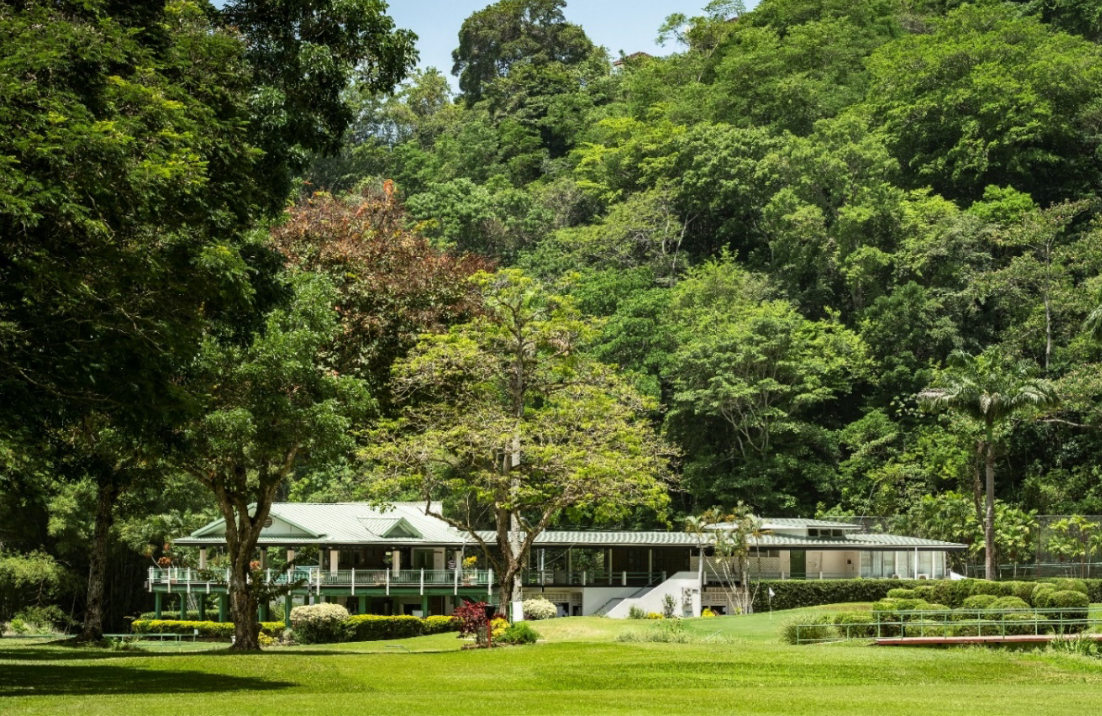
St Andrews G.C Moka, Maraval
1976 - The History of St Andrews “From the Savannah to Moka” – John Sellier, with contributions from Robert Sellier and Roy Rudder.
2023 - Revised & condensed by Adrian Sampson

